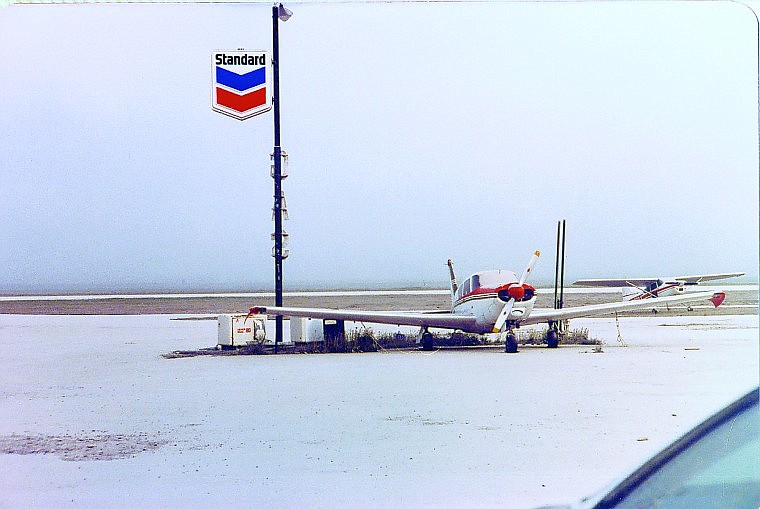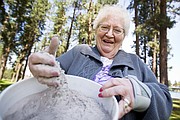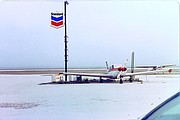Ash Sunday
Ready or not, it came on May 18, 1980.
Even the North Idaho residents who had heard about the surprising eruption of Mount St. Helens between Seattle and Portland at 8:32 a.m. that day went about their business on the lazy, sunny Sunday.
But, by mid-afternoon, it was dark and became one of those rare dates that would be forever etched in the minds of many.
What looked like an eerie massive thunderstorm rolling in from the West was volcanic ash from the eruption nearly 400 miles away.
As ash blanketed the region, people scrambled to get home due to low visibility and a lack of knowledge on whether the material was hazardous.
"We didn't know what was coming," said Kootenai County Sheriff Rocky Watson, who was also the local sheriff at the time. "It was new to us. It had never happened before. There was a lot of misinformation early on that the ash was acidic or poisonous."
Press climatologist Cliff Harris calls it the most unusual weather event of his lifetime.
With the 30th anniversary of the eruption on Tuesday, local residents recall Helens putting their regular lives on hold a few days. Some roads and businesses were closed. Major events, including Aerospace Day at Fairchild Air Force Base that day and even the Coeur d'Alene Marathon the following weekend, were cancelled.
"In the Pacific Northwest and around the world, people awoke to the idea of what it meant to live near an active volcano," said Carolyn Driedger, a U.S. Geological Survey hydrologist.
The ones who dared to venture outside wore surgical masks or handkerchiefs until they learned the ash wasn't dangerous.
Air filters were difficult, if not impossible, to find.
Some, including Darlene Gregg of Post Falls, have kept jars of ash to this day as a vivid reminder of the event's impact and historical significance.
She was off for three days as a postal carrier.
"They told us to not drive on the routes, which was very unusual," she said.
Unknown causes chaos
No one imagined the ash would reach this far, but then came advisories to stay off the roads, head for home and close your windows.
"Winds from the southwest pushed it over us," Harris said.
Bob Thomas was taking photos near the Third Street boat launch in Coeur d'Alene when the best photo of all was in the sky coming toward him.
"I saw a funny-looking, dark, banked cloud coming across the lake, so I took a picture," he said. "I've taken a lot of pictures of clouds, but this one really impressed me."
It wasn't until he got home that Thomas learned that the volcano erupted.
Also near the beach, Jim Lyon was playing basketball at Coeur d'Alene City Park when the once-bright sky turned dark.
"We were watching the ash fall and wondering what was going on," he said. "Then all the lights began turning on around the park as they must have been on light sensors."
Dick Easterly, who lives between Post Falls and Coeur d'Alene, was also oblivious to the news earlier in the day and went on a canoe trip on the Little North Fork of the Coeur d'Alene River. By the time Helens blew, his group was out of radio reception.
"As we were loading up at the end of the trip, I noticed the western horizon was taking on a dark gray color resembling a heavy thunderstorm," Easterly said. "As we started up Fourth of July, I noticed visibility was very much reduced, but no moisture was falling. I rolled down my window and got my first smell of the ash that reduced visibility to feet.
"Through good luck, careful driving and the grace of God, I was able to return home without any problems."
Dave Walker was in traffic lined up to get into Aerospace Day at Airway Heights when several vehicles, including the one he was in, simultaneously did a 180.
"We were all rocking along with the radio when we heard the event was cancelled because of Mount St. Helens," Walker said.
Post Falls Mayor Clay Larkin was fishing on Lake Pend Oreille and, like others, originally shrugged off the news from the coast. But the advisories and darkness made his family quickly cut bait.
"It took us more than two hours to get home (from Farragut State Park)," he said, referring to the poor visibility.
Harris was in a Bible study at the time - ironically learning about Revelation.
"It was pitch black and I remember one of the kids asking if it was the end of the world," Harris said.
Ash aftermath
The next morning, residents woke up to about a half an inch of ash on the ground. About an inch fell on areas to the south.
"It seemed like Coeur d'Alene was on the edge of it," Thomas said. "The dust (ash) was very fine, but somewhat abrasive."
Life was at a standstill for some.
Gregg remembers taking in the world from her window, reluctant to go outside. People were glued to their TVs and radios, hoping for advice on what not to do.
"We were told at first to not let pets out, which was almost impossible," she said. "But we did put our dog on a leash and went with her. You could see where insects had been in the ash on our driveway. It was really kind of different."
Easterly planned on more recreation that week, but it wasn't meant to be.
"I became very angry because this was the start of a scheduled week's vacation," he said. "As it turned out, the week was spent basically under house arrest with only trips for basic necessities made."
People who ventured out ran the risk of damaging their engines.
"The dusty air would clog the carburetor and some machinery and cars stopped running because of it," Thomas said.
Larkin, who was with the fire department at the time, said the department was everyone's best friend and became maxed out.
"We washed down parking lots, school buses, cars, you name it," Larkin said. "What we did not know was the damage the ash did to the diesel engines of the fire trucks. We eventually had to replace both engines at a cost of more than $6,000 each."
Watson said it took weeks for the ash to settle into the ground.
"Every time a car went by, it would stir up the ash again," he said. "The highway districts kept having to wash it off the roads. Slowly, Mother Nature layered it in."
Gregg said the ash proved to be great fertilizer.
"Our hanging plants really grew," she said.
After fears were alleviated, the mood lightened.
Harris recalls a surgical mask being placed over the mouth of a Col. Sanders statue at a Kentucky Fried Chicken restaurant.
Lyon said he and a friend tried turning the ash into profit by selling it through newspaper ads across the country, while other entrepreneurs sold figurines made from it. While the figurines are still sold today, Lyon's idea of selling the ash alone fizzled.
"Many wouldn't put it in their papers as we couldn't verify that it was what we said it was - actual Mount St. Helens volcanic ash," he said.
Remnants of the historic event can still be found in some areas, Thomas said.
"If a person goes down to Heyburn State Park, he can dig down and still find a layer of that dust in the ground," he said.





